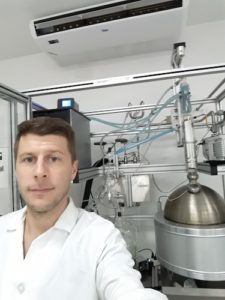
Cannabis Extraction 101
Vape and extract products accounted for 37% of legal cannabis sales in the U.S. in 2020. While flower remains king among consumers (49%), the next closest product category was edibles at 11%*. Cannabis extraction provides cultivators with a growing avenue to experiment with and the opportunity to create high-quality end products with a longer shelf life.
“The barriers to entry are a lot lower than they used to be and there are easy, simple and inexpensive methods to basically turn that crop into something that can be shelf stable for a much longer time than that raw plant matter,” says JJ Chamberlain, an extraction consultant.
Chamberlain, owner of Covalent Consulting LLC, helps cannabis companies develop lab layout, extraction methods, safety procedures and more. Chamberlain shared top considerations for cultivators looking to expand into the extraction product category.

What is the leading extraction process at the moment?
The solvent that is the most efficient and creates all the dabbable products that people want is hydrocarbon (using butane and propane). [Dabbable products are highly concentrated materials, such as oils and waxes, that are consumed by allowing the material to vaporize and inhale.] That’s No. 1 just because it’s the most efficient and it’s creating the consistencies people want. It is the most dangerous one out of CO₂, hydrocarbon and non-solvent extractions. It’s the most dangerous one but it gets the best products out there and it’s not so dangerous that it’s unteachable.
How does CO₂ extraction compare to hydrocarbon extraction?
CO₂ [extraction] is really good for going straight into edibles. [It] can make those dabbable products, it’s just more difficult on the chemists in these production labs. Or there are a lot of machines where if you can dial it in with the drying team and the grow team, you can get the vape pen oil to come directly out of the machine and
can almost go into the vape pen with very little post processing and no additives. And people are really looking for that out of vape pens in this industry to just be pure THC, or as close as we can get it. So CO₂ systems are getting more advanced every year and they’re getting more intuitive. The first one we worked on had a bunch of manual valves. You had to time things with your phone or a kitchen timer for when you were going to turn the valve. It really wasn’t very conducive to our industry at all. Nowadays, software and a lot of the systems are a lot simpler and more intuitive.
We just installed [a Green Mill machine] in Missouri and they’ve come up with a dewaxing technique to create a more pure product straight out of the machine that requires less post processing. We’ve had dewaxing for a while but [Green Mill’s technique] just creates a higher quality product out of the machine. Stuff like that puts [CO₂ extraction] on an equal level as the hydrocarbon.
How can labs keep their environment safe?
Proper training. Making sure everybody knows how these chemicals act in the real world. Let’s say you have a leak of butane. Is that butane going to float all the way up to the ceiling or sink on the ground? Know what you’re working with and what the dangers are.
You need sprinklers and fire suppression systems. A lot of times regulators are now looking for chemical fume hoods to be in a lot of these post-processing rooms. For example, you can put your entire hydrocarbon extraction system in a giant [walk- in] chemical fume hood that will evacuate the butane, propane or CO₂, whenever it reaches an unsafe level. A lot of those are automated. They are a little expensive but they’re worth it and they literally save lives. Ventilation has to be No. 1 in any of these safety systems.
There are safe methods to do a lot of this stuff. So if they follow the method and follow the people that have done it before, and even bring in other safety and chemical ideas from other industries, it’s only going to get safer and better and easier for those with less expertise to operate equipment safely.
What does compliance look like in the extraction industry?
Seed to sale tracking is essential, and it’s part of every industry in every state. Almost every state uses software (such as Metrc or BioTrack) to help us really keep track of everything from seed to sale. And one of the difficult things on the cannabis side — I should say on the extraction side — is being able to keep track of everything that’s going on. There’s tons of moving pieces. You’re combining batches, you’re taking away from batches and putting them into this and that. Then the other part is the setup — the part that I do — to really give everyone all the tools they’ll need to make sure they’re compliant and safe, and make sure that these systems can do what they say they do and that they’re all rated to evacuate the amount of air in that room and be able to keep everybody safe.
There’s the whole set up about it, and all the equipment and the processes, and kind of creating processes so that people have no choice but to be compliant if they’re following the process. You set [your extraction process] up so that compliance is almost built into the entire network, from start to finish.



